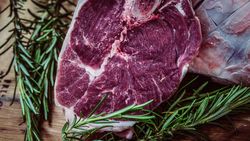Meats
Have you ever really thought about your meat? Why is beef meat very red, while poultry is pale? Why does a medium rare steak have “blood” leaking out? Why is meat in the supermarket so red? How can you tell when meat has been cooked? Why does whole beef and ground beef need to be cooked to different temperatures? Well, keep reading to learn the answers of these questions.
Chemistry of Muscle Tissue
Color
Meat is muscle tissue and contains several meat pigments; hemoglobin, myoglobin, and cytochrome c. The main pigment involved in the color of meats is myoglobin, a protein found only in muscles. Myoglobin has two parts; a protein component called globin and the non-protein portion is the heme ring that carries an iron atom.
When meat is first butchered, the myoglobin is purple and chemically is classified as deoxymyoglobin (DMb) (no oxygen is bound to the tissue). As the meat is processed and exposed to air, the iron atom in the heme ring contains a binding site that oxygen in the air binds to. Once oxygen binds to the iron the compound oxymyoglobin (OMb) is formed. This will cause the meat to transform to a red color.
Over time, the iron will oxidize (lose an electron) and lose its ability to bind oxygen (but water will bind to the site); during this state the meat will turn a grayish/brown color and will be metmyoglobin (MMb).
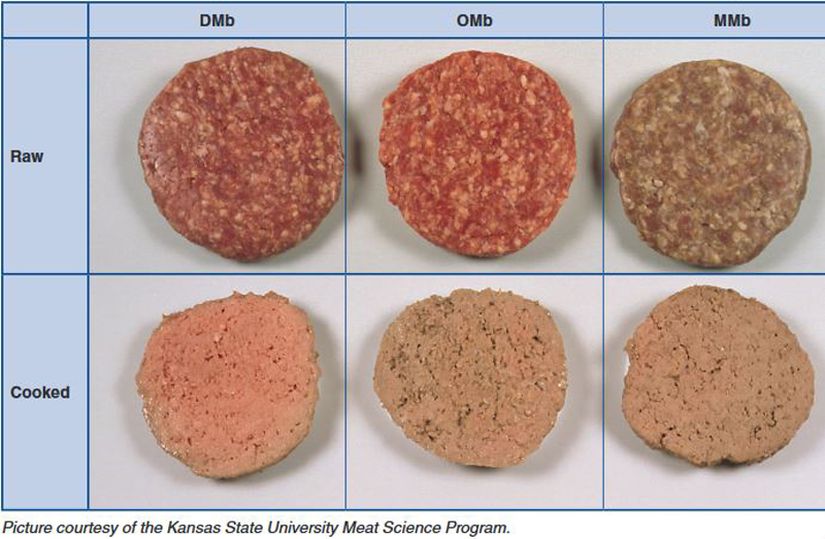
Depending on the cut of meat there will be different amounts of myoglobin present, muscles used in locomotion and movement will have increased amounts present. As an animal ages, more myoglobin will be in the muscle tissues. Animals also have different amounts of myoglobin present. Beef has a lot and poultry has much lower levels, so there is less color in chicken meat. Lamb and pork have intermediate amounts and will have more color than poultry, but less than beef typically.
Most consumers prefer meat to be red as they think it is fresher. We now know that this is not true. The redness of the meat does not reflect the freshness of it. However, most people do not know this, and grocery stores have devised a few ways to combat consumers avoiding purchasing meats that have naturally changed colors. For example, to guarantee a red color sticks around longer in ground meats, they will be wrapped in packages that allow continuous oxygen to flow in and liquids to stay within the package. This oxygen will bind to myoglobin to form oxymyoglobin and keep it looking red longer. If the bag was impermeable all the oxygen in the package would be consumed in 1-2 days and most of the meat will be in the metmyoglobin stage and be grayish/brown in color.
In some countries like the United States, it is common to see all the meats in the meat section to have a uniform bright red color. This is due to packaging the meat with carbon monoxide. As myoglobin has a high binding affinity to carbon monoxide and when the two are combined, they form carbon monoxide myoglobin which is bright red in color and gives the meat a bright red color that consumers love.
What is That Liquid? Is That Blood?
Meat is also around 75% water and depending on the iron stage there can be water binding to the iron heme (metmyoglobin). The liquid you see in meat packaging and what leaks out during the cooking process is water and myoglobin leaking from the meat, and while it looks like blood it is not.
A rare steak is cooked to an internal temperature of 125°F /52°C and will retain the most water and myoglobin, but some of it will run onto the plate during the eating process. A steak cooked to a higher temperature will cause more of the water and myoglobin to be released in the pan (causing a drier steak), such as a well done steak that is cooked to an internal temperature of 160°F/71°C.
Further, the longer the heat sensitive myoglobin is being exposed to heat a chemical reaction will change the meat from red to a pink and if cooked long enough to a gray/tan color. Although if we are being technical, a hemichrome pigment that is the result of denatured globin and oxidized heme iron.
Where is the Blood?
So, where is the blood? Meat is an animal’s muscles and we know muscles need blood to deliver oxygen, nutrients, and remove waste from the muscles.
Evrim Ağacı'nın çalışmalarına Kreosus, Patreon veya YouTube üzerinden maddi destekte bulunarak hem Türkiye'de bilim anlatıcılığının gelişmesine katkı sağlayabilirsiniz, hem de site ve uygulamamızı reklamsız olarak deneyimleyebilirsiniz. Reklamsız deneyim, sitemizin/uygulamamızın çeşitli kısımlarda gösterilen Google reklamlarını ve destek çağrılarını görmediğiniz, %100 reklamsız ve çok daha temiz bir site deneyimi sunmaktadır.
KreosusKreosus'ta her 50₺'lik destek, 1 aylık reklamsız deneyime karşılık geliyor. Bu sayede, tek seferlik destekçilerimiz de, aylık destekçilerimiz de toplam destekleriyle doğru orantılı bir süre boyunca reklamsız deneyim elde edebiliyorlar.
Kreosus destekçilerimizin reklamsız deneyimi, destek olmaya başladıkları anda devreye girmektedir ve ek bir işleme gerek yoktur.
PatreonPatreon destekçilerimiz, destek miktarından bağımsız olarak, Evrim Ağacı'na destek oldukları süre boyunca reklamsız deneyime erişmeyi sürdürebiliyorlar.
Patreon destekçilerimizin Patreon ile ilişkili e-posta hesapları, Evrim Ağacı'ndaki üyelik e-postaları ile birebir aynı olmalıdır. Patreon destekçilerimizin reklamsız deneyiminin devreye girmesi 24 saat alabilmektedir.
YouTubeYouTube destekçilerimizin hepsi otomatik olarak reklamsız deneyime şimdilik erişemiyorlar ve şu anda, YouTube üzerinden her destek seviyesine reklamsız deneyim ayrıcalığını sunamamaktayız. YouTube Destek Sistemi üzerinde sunulan farklı seviyelerin açıklamalarını okuyarak, hangi ayrıcalıklara erişebileceğinizi öğrenebilirsiniz.
Eğer seçtiğiniz seviye reklamsız deneyim ayrıcalığı sunuyorsa, destek olduktan sonra YouTube tarafından gösterilecek olan bağlantıdaki formu doldurarak reklamsız deneyime erişebilirsiniz. YouTube destekçilerimizin reklamsız deneyiminin devreye girmesi, formu doldurduktan sonra 24-72 saat alabilmektedir.
Diğer PlatformlarBu 3 platform haricinde destek olan destekçilerimize ne yazık ki reklamsız deneyim ayrıcalığını sunamamaktayız. Destekleriniz sayesinde sistemlerimizi geliştirmeyi sürdürüyoruz ve umuyoruz bu ayrıcalıkları zamanla genişletebileceğiz.
Giriş yapmayı unutmayın!Reklamsız deneyim için, maddi desteğiniz ile ilişkilendirilmiş olan Evrim Ağacı hesabınıza üye girişi yapmanız gerekmektedir. Giriş yapmadığınız takdirde reklamları görmeye devam edeceksinizdir.
In most of the world, one of the first steps in the slaughtering process is draining most of the blood and its hemoglobin from an animal carcass. While there may be a few red blood cells (that contain the protein hemoglobin that gives blood color) left in the meat, they would be negligible. Blood is drained from the carcass, because the meat would go rancid and spoil much quicker if it was left.

Cooking: How to Cook Meat?
Meat can be cooked in the deoxymyoglobin, oxymyoglobin, metmyoglobin stages and will be completely safe to eat. All stages of the meat once cooked will look mostly tan, but there are some subtle differences. Meat that was largely in the deoxymyoglobin state prior to cooking will look pinker than largely metmyoglobin meats. So, if you cook based on the color you may actually overcook your meat based on the pigments.
However, other factors can all cause you to incorrectly cook your meats. For example, meats pH levels can cause meat to prematurely brown before reaching safe temperatures. You can read about this, and how other factors like reducing activity, meat respiration rates, microbial loads and more can have an impact on the color from a meat science expert.
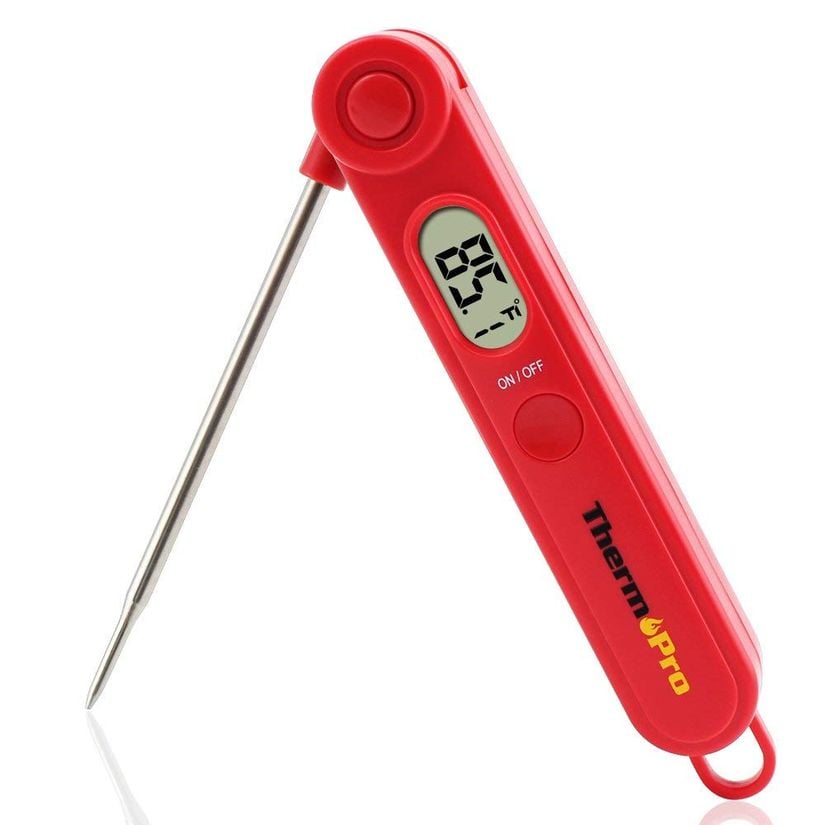
Overall, the final cooked color of meat is not an indicator of doneness. So, one always need to use a food thermometer to ensure the appropriate internal temperature is reached and will help you not overcook your meats too. There are some professional chefs that use a hand technique, because they are afraid of the thermometer causing juices to run out of meats after piercing it to read the internal temperature, but health and government entities do not recommend this technique.
Spoilage: When and How Does the Meat Spoil?
Fresh meats can spoil! We know that color is not a great indicator of freshness, but you can look for spoiling if the meat is very dark in color, sticky, has a strong off odor, and is either slimy or tacky to the touch. If a meat is in question, it is better to dispose of it than risk eating spoiled meat.
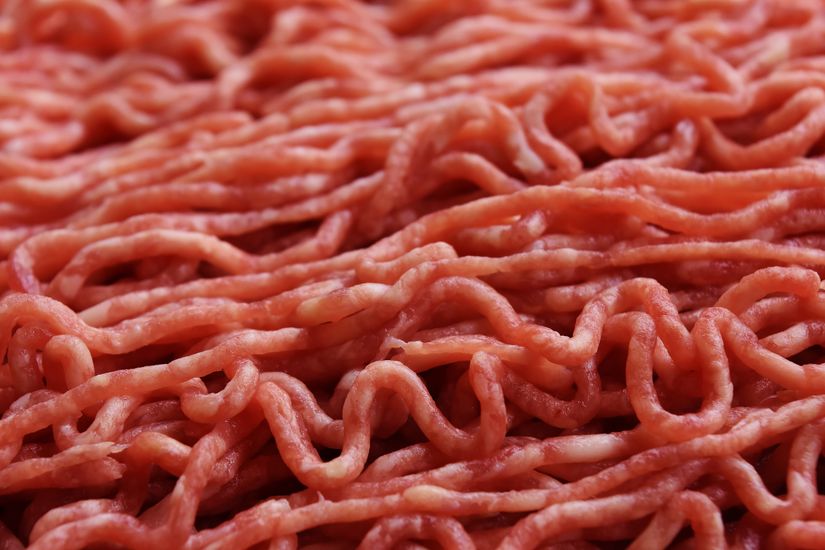
Temperature and Food Safety
If one speaks with chefs, many feel that it is a cardinal sin to order a well done steak as it is dry and a lot of flavor has been lost. Most would recommend rare to medium rare steaks. However, health experts usually recommend steaks to be cooked to a medium level with an internal temperature of 145°F/63°C and rested for a few minutes (during rest the meat temperature will continue to rise) because food bacteria in meat, like Salmonella and E. coli will have their proteins denatured from the heat and a large portion of them will be destroyed to a level that a person would most likely not become sick. While it cannot be guaranteed, most of these bacteria live on the surfaces of meat. So, if you cook your steaks to rare or medium levels, the outside of the meats will become hot enough for the process of destroying Salmonella and E. coli, decreasing this risk. Ground beef should always be cooked to 160°F/63°C, because the outside surfaces of meat are now scattered throughout the meat.
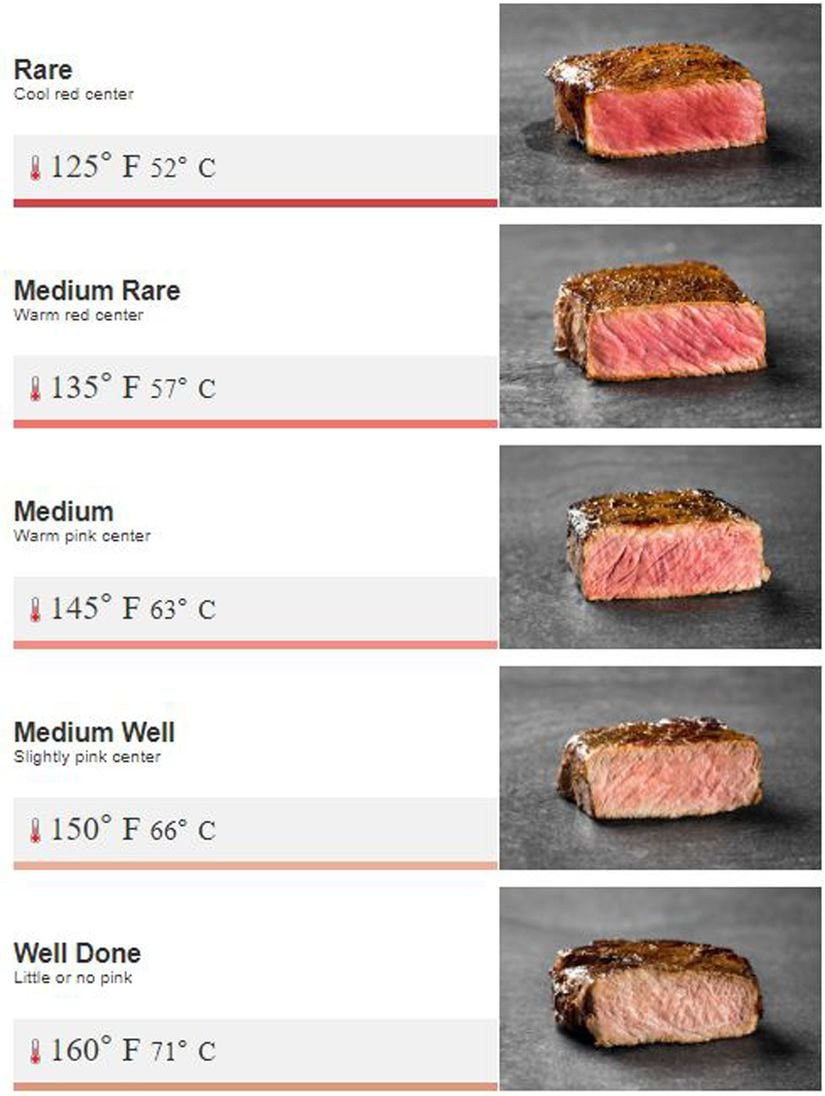
So, what is a person to do when it comes to steak? Sacrifice flavor for safety?
Well, research shows that individuals that are immune compromised, elderly, children, pregnant, should always follow health guidelines and everyone else would be better protected following them too. However, it comes down to a personal choice and understanding of the risks, you can also always talk to your healthcare professional to determine your risk levels and health risks.
- 1
- 0
- 0
- 0
- 0
- 0
- 0
- 0
- 0
- 0
- 0
- 0
- J. R. Claus. Color Changes In Cooked Beef. (17 Mayıs 2019). Alındığı Tarih: 17 Mayıs 2019. Alındığı Yer: Beef Facts | Arşiv Bağlantısı
- J. Schweihofer, et al. The Color Of Meat Depends On Myoglobin: Part 1. (10 Ekim 2014). Alındığı Tarih: 17 Mayıs 2019. Alındığı Yer: Michigan State University | Arşiv Bağlantısı
- J. W. Savell. Meat Science. (1 Temmuz 2015). Alındığı Tarih: 17 Mayıs 2019. Alındığı Yer: University of Texas A&M | Arşiv Bağlantısı
- J. Weinzirl. (1923). Concerning The Relation Of The Bacterial Count To The Puterfaction Of Meat. Annals of the Annual Meeting of the Society of American Bacteriologist, sf: 946-949. | Arşiv Bağlantısı
Evrim Ağacı'na her ay sadece 1 kahve ısmarlayarak destek olmak ister misiniz?
Şu iki siteden birini kullanarak şimdi destek olabilirsiniz:
kreosus.com/evrimagaci | patreon.com/evrimagaci
Çıktı Bilgisi: Bu sayfa, Evrim Ağacı yazdırma aracı kullanılarak 16/12/2025 21:15:20 tarihinde oluşturulmuştur. Evrim Ağacı'ndaki içeriklerin tamamı, birden fazla editör tarafından, durmaksızın elden geçirilmekte, güncellenmekte ve geliştirilmektedir. Dolayısıyla bu çıktının alındığı tarihten sonra yapılan güncellemeleri görmek ve bu içeriğin en güncel halini okumak için lütfen şu adrese gidiniz: https://evrimagaci.org/s/7800
İçerik Kullanım İzinleri: Evrim Ağacı'ndaki yazılı içerikler orijinallerine hiçbir şekilde dokunulmadığı müddetçe izin alınmaksızın paylaşılabilir, kopyalanabilir, yapıştırılabilir, çoğaltılabilir, basılabilir, dağıtılabilir, yayılabilir, alıntılanabilir. Ancak bu içeriklerin hiçbiri izin alınmaksızın değiştirilemez ve değiştirilmiş halleri Evrim Ağacı'na aitmiş gibi sunulamaz. Benzer şekilde, içeriklerin hiçbiri, söz konusu içeriğin açıkça belirtilmiş yazarlarından ve Evrim Ağacı'ndan başkasına aitmiş gibi sunulamaz. Bu sayfa izin alınmaksızın düzenlenemez, Evrim Ağacı logosu, yazar/editör bilgileri ve içeriğin diğer kısımları izin alınmaksızın değiştirilemez veya kaldırılamaz.

